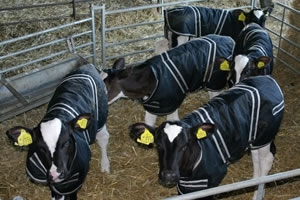 December temperatures have been unusually warm, but we can expect to soon be reminded of the realities of Cache Valley winters. Energy requirements for animals increase as air temperatures decrease, and in Cache Valley, January is often the coldest month of the year. As such, livestock and dairy producers must pay close attention to the needs o f their animals. Adequate housing and proper nutrition are the major considerations for all animals, but this is especially true for baby calves. Knowing how valuable calves are, successful producers will give careful attention to every detail.
December temperatures have been unusually warm, but we can expect to soon be reminded of the realities of Cache Valley winters. Energy requirements for animals increase as air temperatures decrease, and in Cache Valley, January is often the coldest month of the year. As such, livestock and dairy producers must pay close attention to the needs o f their animals. Adequate housing and proper nutrition are the major considerations for all animals, but this is especially true for baby calves. Knowing how valuable calves are, successful producers will give careful attention to every detail.Profitable livestock producers focus on the five essential C’s of Colostrum, Cleanliness, Comfort, Calories and Consistency. Books have been written on each of these topics. The five C’s become increasingly important when the weather turns ugly.
In order to receive adequate immunity, baby Holstein calves should consume at least one gallon of colostrum within 4 to 6 hours of birth. Smaller Jersey calves will need much less. Calves that do not receive enough antibodies at birth are at increased risk for sickness or death throughout the entire growing period. The most important step in any calf health program is successful colostrum management.
Cleanliness of feeding utensils and housing is another priority for successful calf raisers. Simply rinsing and storing the utensils is never good enough. After rinsing, all equipment should be washed with the use of water at least 120 degrees Fahrenheit. It is also recommended to include a detergent and a disinfectant in order to do a good job of cleaning nipples, buckets, balling guns and stomach tubes. Many successful calf feeders have an automatic dishwasher at the barn for washing nipples and bottles. Acid sanitizers may be needed from time to time to remove any remaining milk solids on the containers. After washing, always rinse with cold water.
Baby dairy calves should be housed in comfortable individual pens or hutches, and in an environment that is dry, well-drained, properly ventilated and free of drafts. Always keep the calves comfortable with adequate dry bedding. Straw and/or wood shavings make excellent bedding. An adequate bedding nest can reduce the incidence of respiratory diseases. Calves that are well -bedded are able to use energy to maintain their immune systems instead of expending fat reserves to regulate body heat. More liberal bedding of calf hutches can reduce heat loss and is a source of insulation for the calf. The use of calf blankets also reduces body heat loss and helps increase the internal temperature of baby calves during cold snaps. Face calf hutches to the south to get maximum benefit from sunlight.
Extra milk or milk replacer, in addition to a quality calf starter, also helps calves deal with cold weather. One school of thought is to provide extra calories by feeding milk replacer that is higher in fat content. Fat, however, must be digested and providing more fat means that the calf has to expend energy to digest a diet they may not be accustomed to. Research has shown that feeding milk replacer three times per day will help stabilize the pH in the rumen of the calf for better feed efficiency. Providing water to calves also helps maintain hydration and encourages increased consumption of calf starter. In winter months, it is recommended that warm water be offered soon after calves drink their milk and before they lie down. Water not consumed will need to be discarded before it freezes.
Consistency is another priority for improving the health and growth of baby dairy calves. Newborn calves are indeed babies, and babies respond well to a routine schedule of feeding and care. Being creatures of habit, calves always respond best when fed at the same time and with the same routine. Any variation in the feeding schedule will have a negative effect on the well-being of baby calves.
An optimal dry cow feeding program is another critical element to calf survival and development, especially during cold winter months. The body condition and nutritional level of dry cows has direct impact on the survivability of newborn calves. Calves born to well-fed dry cows are stronger, more aggressive and carry additional reserves of body fat. The quality of colostrum produced by well managed dry cows is usually better too.
I have noted that successful dairy producers frequently have excess heifer calves or springer heifers to sell while marginal producers often need to buy replacement heifers. Giving watchful attention to successfully raising baby calves is a focus that always pays big dividends.
Source: Utah State Extension









